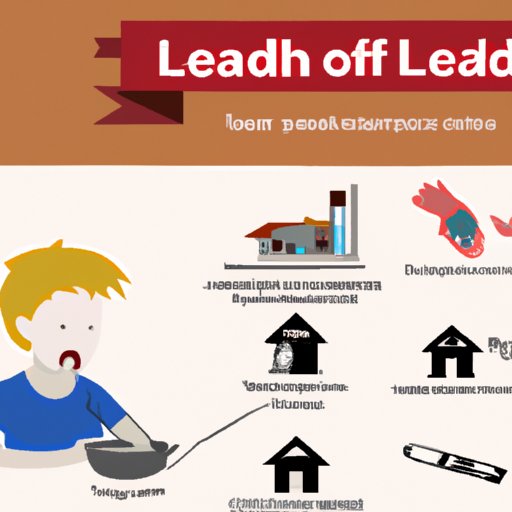Introduction
Lead poisoning is a serious health concern that can have lasting negative impacts on individuals and entire communities. It is caused by exposure to lead, a heavy metal commonly found in paint, plumbing, and other materials in the home and environment. Lead poisoning is especially dangerous for children, as it can cause neurological damage, behavioral changes, and developmental delays. The purpose of this article is to explore what lead poisoning looks like, including the symptoms, sources, and treatment of lead exposure.

Exploring the Symptoms of Lead Poisoning
The symptoms of lead poisoning vary depending on the level of lead exposure. According to the Centers for Disease Control and Prevention (CDC), some of the most common signs and symptoms of lead poisoning include abdominal pain, constipation, headaches, irritability, loss of appetite, and memory problems. In more severe cases, lead poisoning can cause seizures, coma, and even death.
It can be difficult to determine if lead exposure is the cause of certain symptoms, as the signs and symptoms of lead poisoning can mimic other health issues. If you suspect that you or your child may have been exposed to lead, it is important to speak with a healthcare provider who can order blood tests to diagnose lead poisoning.
Investigating Sources of Lead Exposure
Lead is found in many places in the environment, including soil, water, dust, and air. It can also be found in older paint, plumbing, and other materials in the home. According to the Environmental Protection Agency (EPA), lead is particularly dangerous for young children, as they are more likely to come into contact with lead-containing materials and ingest lead particles.
In addition to older paint and plumbing, potential sources of lead exposure in the home include toys and furniture made with leaded paint, imported foods and spices, and jewelry and trinkets containing lead. It is important to be aware of these potential sources of lead exposure and take steps to reduce the risk of lead poisoning.
Examining the Long-Term Effects of Lead Poisoning
Lead poisoning can have serious long-term effects, particularly in children. Exposure to lead can cause neurological damage, resulting in learning disabilities, decreased IQ, and difficulty with concentration and focus. Lead poisoning can also cause behavioral changes, such as aggression, hyperactivity, and impulsivity. In addition, lead poisoning can lead to developmental delays and physical growth problems.
According to a study published in the journal Environmental Health Perspectives, “Lead poisoning has been linked to a range of adverse health effects, including increased risk of cardiovascular disease, hypertension, kidney dysfunction, and infertility.” The study also noted that lead exposure is associated with an increased risk of cancer.

Understanding the Diagnosis and Treatment of Lead Poisoning
Blood tests are used to diagnose lead poisoning. The results of the test will indicate the level of lead in the blood, which can help healthcare providers determine the best course of treatment. For mild cases of lead poisoning, treatment may involve removing the source of lead exposure, such as replacing old paint or plumbing. For more severe cases, chelation therapy may be necessary. This involves administering medications that bind to lead and help the body remove it from the bloodstream.
How to Prevent Lead Poisoning in Children
The best way to prevent lead poisoning in children is to reduce their exposure to lead. This can be done by replacing older paint, plumbing, and other materials in the home. Regular cleaning to remove dust and debris containing lead is also important. Additionally, it is recommended to test soil and water for lead, especially if children will be playing in these areas.
The Role of Public Health Education in Lead Poisoning Prevention
Public health education plays an important role in lead poisoning prevention. It is essential to educate parents and caregivers about the dangers of lead, including potential sources of exposure and symptoms of lead poisoning. Additionally, healthcare professionals should be trained on lead risk and prevention strategies to ensure that lead poisoning is identified and treated quickly.

Examining Research on Lead Poisoning in the Home Environment
Several studies have examined lead levels in homes and the impact of lead exposure on children’s health. These studies have found that lead levels in homes can be significantly higher than the acceptable levels set by the EPA. They have also found that lead exposure can have serious long-term health consequences, including cognitive delays and behavioral problems.
Conclusion
Lead poisoning is a serious health issue that can have lasting negative impacts on individuals and entire communities. This article explored what lead poisoning looks like, including the symptoms, sources, and treatment of lead exposure. It is important to be aware of the potential sources of lead exposure in the home and take steps to reduce the risk of lead poisoning. Public health education is essential to ensure that parents and caregivers are aware of the dangers of lead and that healthcare professionals are trained on lead risk and prevention strategies.
(Note: Is this article not meeting your expectations? Do you have knowledge or insights to share? Unlock new opportunities and expand your reach by joining our authors team. Click Registration to join us and share your expertise with our readers.)
